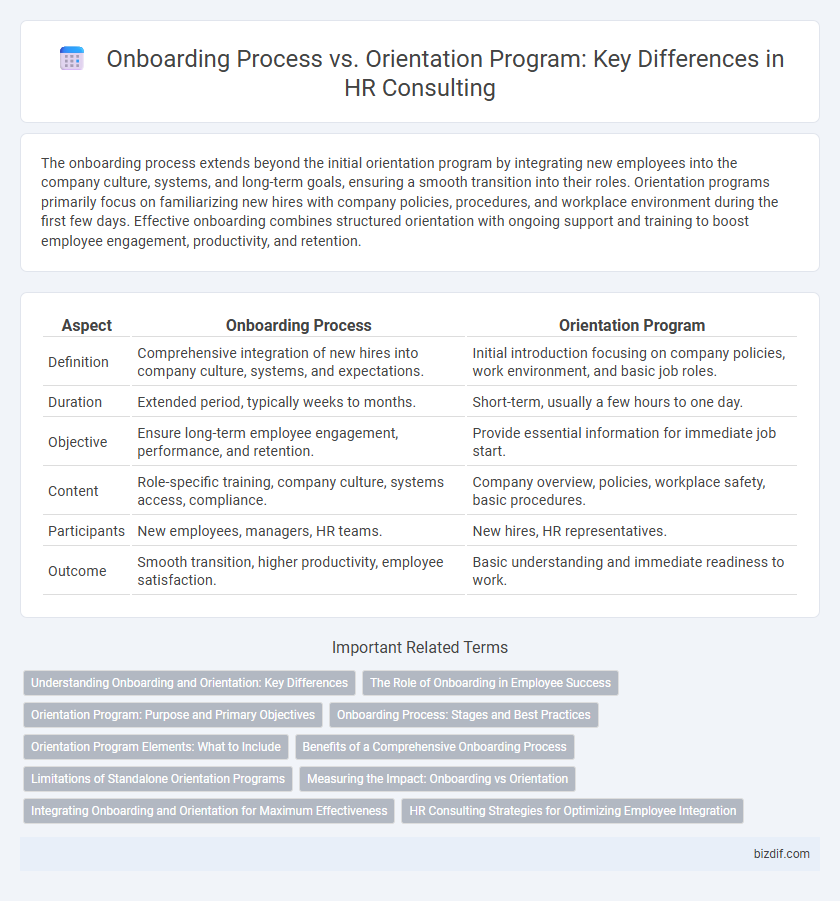The onboarding process extends beyond the initial orientation program by integrating new employees into the company culture, systems, and long-term goals, ensuring a smooth transition into their roles. Orientation programs primarily focus on familiarizing new hires with company policies, procedures, and workplace environment during the first few days. Effective onboarding combines structured orientation with ongoing support and training to boost employee engagement, productivity, and retention.
Table of Comparison
| Aspect | Onboarding Process | Orientation Program |
|---|---|---|
| Definition | Comprehensive integration of new hires into company culture, systems, and expectations. | Initial introduction focusing on company policies, work environment, and basic job roles. |
| Duration | Extended period, typically weeks to months. | Short-term, usually a few hours to one day. |
| Objective | Ensure long-term employee engagement, performance, and retention. | Provide essential information for immediate job start. |
| Content | Role-specific training, company culture, systems access, compliance. | Company overview, policies, workplace safety, basic procedures. |
| Participants | New employees, managers, HR teams. | New hires, HR representatives. |
| Outcome | Smooth transition, higher productivity, employee satisfaction. | Basic understanding and immediate readiness to work. |
Understanding Onboarding and Orientation: Key Differences
The onboarding process encompasses a comprehensive approach to integrating new hires, including training, socialization, and performance expectations over several weeks or months. Orientation programs are typically a one-time event focused on introducing company policies, workplace culture, and basic job information. Understanding these differences allows HR consultants to design effective strategies that improve employee retention and engagement by addressing both immediate informational needs and long-term assimilation.
The Role of Onboarding in Employee Success
Effective onboarding integrates company culture, role clarity, and performance expectations to accelerate employee productivity and retention. Unlike basic orientation that covers administrative tasks, onboarding fosters deeper engagement through tailored training, mentorship, and continuous feedback. Research from the Society for Human Resource Management (SHRM) indicates that comprehensive onboarding boosts new hire retention by 82% and improves productivity by over 70%.
Orientation Program: Purpose and Primary Objectives
The Orientation Program aims to familiarize new employees with the company culture, policies, and their specific job roles, ensuring a smooth transition into the workplace. Its primary objectives include building employee engagement, reducing early turnover, and accelerating productivity by providing essential information and resources. Effective orientation programs enhance long-term retention by fostering a sense of belonging and alignment with organizational goals.
Onboarding Process: Stages and Best Practices
The onboarding process consists of key stages: pre-boarding, where paperwork and initial introductions occur; the first day, focused on welcoming and setting expectations; and the integration phase, which ensures ongoing training and cultural assimilation. Best practices include personalized onboarding plans, continuous feedback loops, and leveraging technology for seamless communication and resource access. Effective onboarding enhances employee engagement, reduces turnover, and accelerates productivity by fostering a supportive and structured transition into the company.
Orientation Program Elements: What to Include
Effective orientation programs in HR consulting should include company culture immersion, clear communication of job roles and expectations, and comprehensive benefits and policies overview. Incorporating interactive sessions, mentorship introductions, and facility tours enhances employee engagement and accelerates productivity. Providing resources such as employee handbooks, compliance training, and technology setup ensures smooth transition and long-term retention.
Benefits of a Comprehensive Onboarding Process
A comprehensive onboarding process enhances employee retention by fostering engagement and reducing turnover rates within the first year. It accelerates productivity through tailored training programs and clear role expectations, ensuring faster adaptation to company culture and workflows. Effective onboarding also minimizes compliance risks by thoroughly familiarizing new hires with organizational policies and regulatory standards.
Limitations of Standalone Orientation Programs
Standalone orientation programs often lack comprehensive integration, causing new hires to feel disconnected from company culture and ongoing workflows. Such programs typically offer limited interaction beyond initial introductions, resulting in slower employee productivity and engagement. Without continuous support and personalized onboarding, organizations risk higher turnover rates and prolonged adjustment periods.
Measuring the Impact: Onboarding vs Orientation
Measuring the impact of onboarding versus orientation involves evaluating employee performance, retention rates, and engagement levels within the first 90 days. Onboarding processes typically show higher effectiveness in long-term productivity and cultural assimilation compared to one-time orientation programs, which primarily provide initial information. Analyzing metrics such as time-to-productivity and employee satisfaction surveys helps HR professionals optimize these programs for better talent integration.
Integrating Onboarding and Orientation for Maximum Effectiveness
Integrating onboarding and orientation programs enhances employee assimilation by combining comprehensive job training with company culture introduction, accelerating productivity and engagement. Effective onboarding extends beyond initial orientation by including ongoing support, mentorship, and feedback loops, ensuring sustained employee development. Metrics such as reduced turnover rates, improved time-to-productivity, and higher employee satisfaction scores demonstrate the success of a unified integration strategy in HR consulting.
HR Consulting Strategies for Optimizing Employee Integration
HR consulting strategies emphasize a structured onboarding process that extends beyond the initial orientation program to ensure thorough employee integration and engagement. A comprehensive onboarding process includes tailored training, goal alignment, and continuous feedback, which enhances retention rates and accelerates productivity. Effective HR consulting leverages data-driven insights and personalized support to create a seamless transition for new hires, fostering long-term organizational commitment.
Onboarding Process vs Orientation Program Infographic

 bizdif.com
bizdif.com